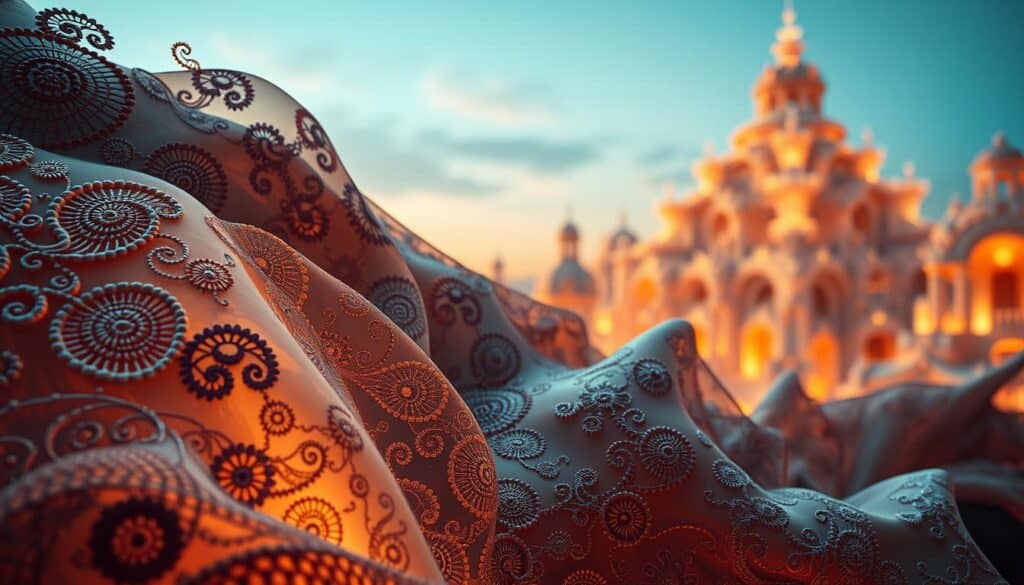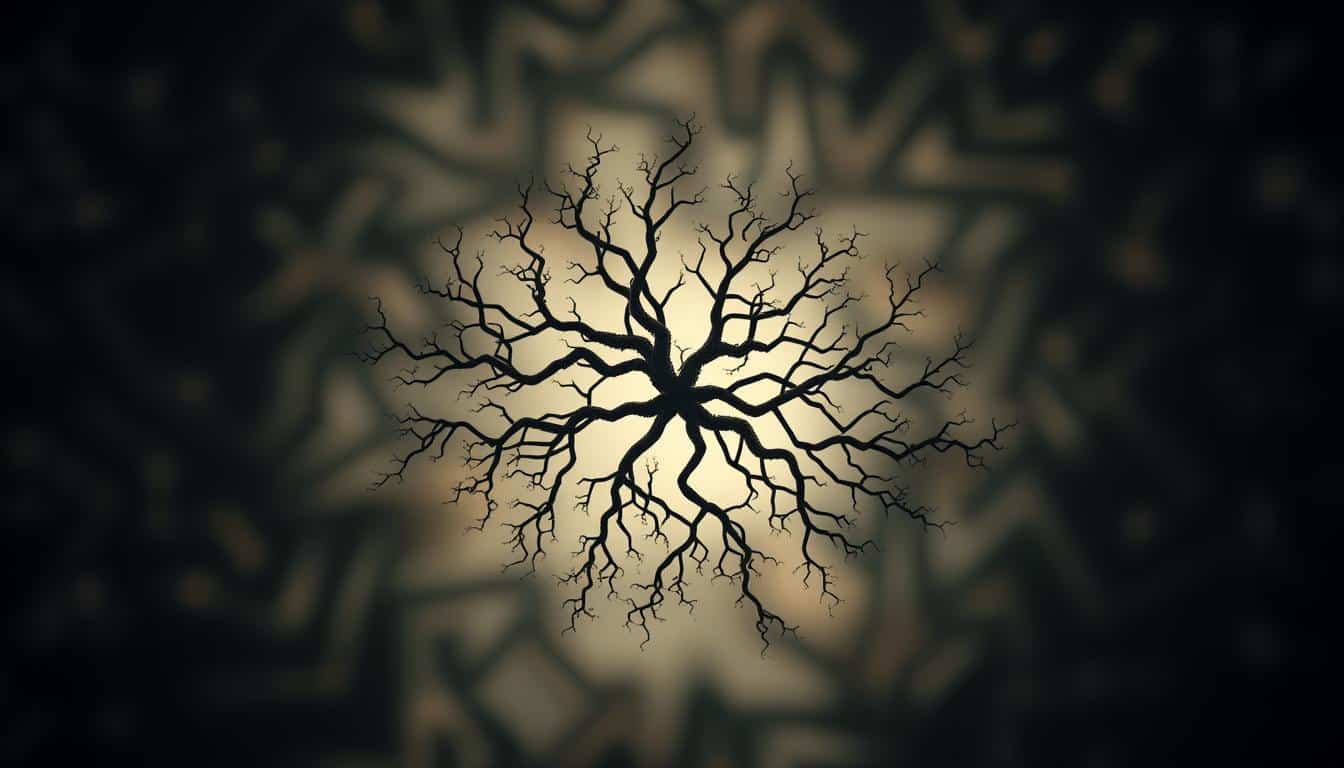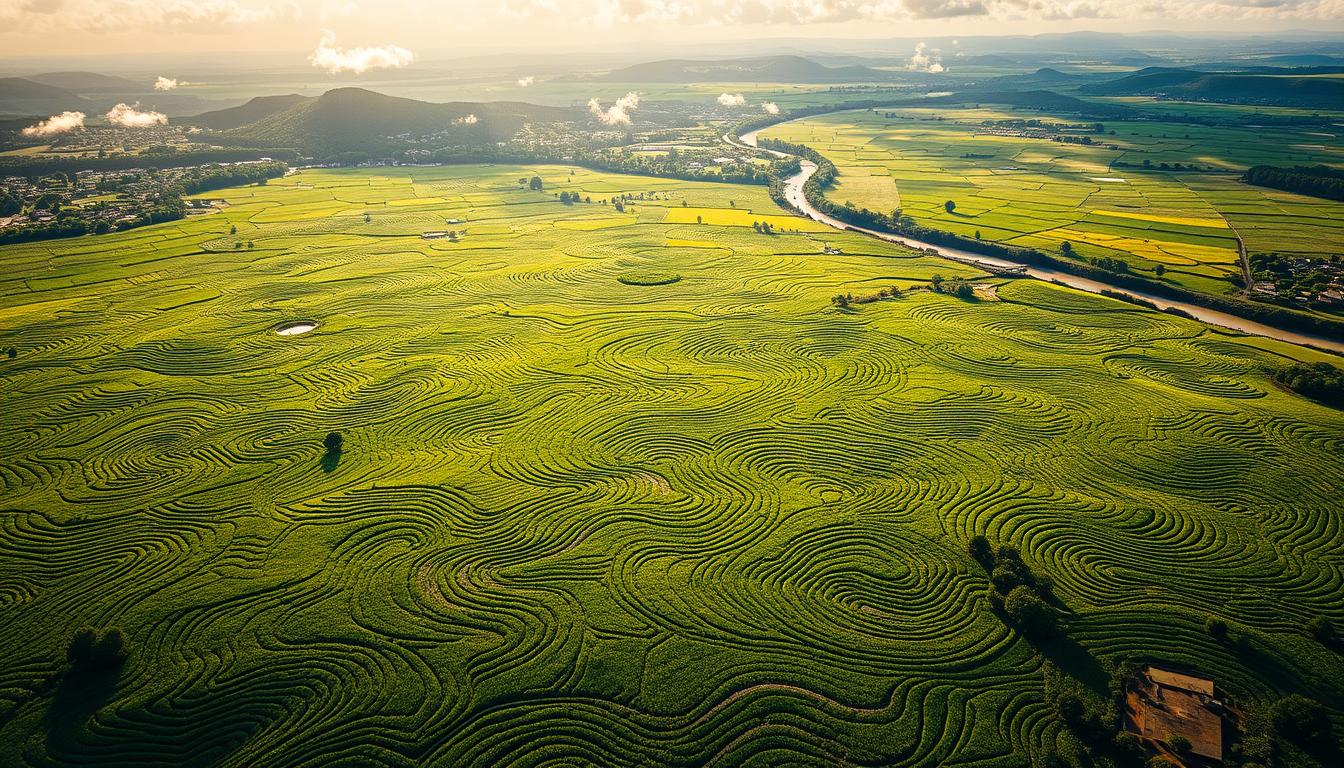Fractal patterns have become a major player in fashion and textiles, blending art and math. This mix enhances both the look and practicality of clothes, leading to detailed designs. These designs bring out feelings of balance and intricacy.
By using the beauty in nature, the trend of fractals widens the creative options. This includes clothing, accessories, and home décor.
The Genesis of Fractal Patterns in Fashion
Benoit Mandelbrot, a mathematician, introduced fractal geometry in the 1970s. This math concept shows how complex shapes look similar at different scales. Fractals in design started from wanting to mimic nature’s detailed beauty.
These patterns capture organic structures’ essence. They also bring calmness and harmony visually.
Understanding Fractals and Their Origin
Fractals are more than complex math ideas; they mirror nature’s beauty in things like trees and coastlines. Knowing about fractals helps architects, artists, and fashion designers get inspired by nature. As we learn more about fractals, we see how geometry blends with creativity, creating eye-catching art.
Benoit Mandelbrot: The Father of Fractal Geometry
Benoit Mandelbrot changed math and design with his work on fractal geometry. His ideas made us see complexity and beauty in art and fashion differently. Designers use his concepts to create patterns that resemble nature’s details. Mandelbrot’s work has influenced academics and led to unique textiles in fashion.

Fractal Patterns in Fashion Design and Textile Industry
Fractal patterns are changing the game in fashion design. They bring a unique look that grabs everyone’s attention. Designers are using fractals to add complex details to clothes, mixing art with math. This shift has led to groundbreaking styles that redefine fashion and inspire others.
Impact of Fractals on Contemporary Design
Fractal designs are making a big splash in textiles. They use math to create eye-catching patterns. These designs are not just beautiful. They also have deep meanings. This blend of art and science is getting a lot of praise in the fashion world.
Pioneering Designers Embracing Fractals
Jhane Barnes is a big name in fractal fashion. She has turned traditional weaving into something new. By using computer-made fractals, these designers are leading the way. They are exploring new possibilities in fabric and fashion. With fractals, they are making every piece a mix of math beauty and cutting-edge style.
Mathematics Meets Fashion
Mathematics isn’t just a tool in fashion design. It deeply influences how clothes are made. It merges art with precise science. Designers use geometry to make new shapes and styles. This mix of creativity and math changes how we make clothes. It leads to smart, well-designed pieces.
Beyond Aesthetics: The Role of Mathematics
Math plays many roles in fashion, from creating patterns to shaping fabric. Here are some key areas:
- Pattern Design: Math helps in cutting and sewing patterns efficiently. This saves fabric and reduces waste.
- Shape Creation: Geometry leads to unique styles that tell a story.
- Structural Integrity: With math, clothes can stay in shape longer and fit better.
The Intersection of Creativity and Calculation
Fashion engineering combines creative ideas with math. Designers use geometry and math to:
- Create smart textiles that change with the environment.
- Experiment with shapes to change how clothes look.
- Make clothes that are comfortable and move well.
Technological Advancements in Fractal Textile Design
The use of computer algorithms in fashion has changed textile design in big ways. These tools help create complex fractal patterns, making the design process more creative. Designers are using this tech to discover new beauty in the fashion world.
Computer Algorithms and Their Influence
Computer algorithms are key to making detailed patterns seen in today’s textiles. They use math based on fractals to create unique, resizable patterns. This has opened up new artistic options, offering designs that meet what people want.
Digital Printing Techniques Revolutionizing Production
Digital textile printing is more eco-friendly than old ways of making fabrics. It reduces waste and saves water. By printing on demand, textiles can be personalized with less waste. This shows how technology and eco-friendliness are changing how textiles are made.
Sustainability and Fractal Patterns
The blend of sustainability and fractal patterns is a chance for the textile sector to be creative. By using eco-friendly textiles and focusing on sustainability, brands meet the demand for green products. Fractal designs are interesting to look at and help in cutting waste and using resources better.
Eco-Friendly Materials and Manufacturing Processes
Choosing materials that don’t harm the environment is key for green fashion. Using organic cotton, recycled polyester, or eco-friendly fibers helps lower the industry’s harmful effects. Adding fractal patterns to these materials makes them look cool while staying eco-friendly.
Reducing Waste through Fractal Design
Fractal designs are important for less waste. They allow for better fabric cutting, reducing leftovers. This means using resources more wisely and tackling environmental issues in textiles. Moreover, fractals help in making fashionable yet eco-conscious clothing, supporting a circular economy.
The Role of Fractal Patterns in Sustainable Fashion
The fashion industry is changing because people want eco-friendly products. Fractal patterns have become a key part of this change for brands that want to be sustainable. They show how math and care for the planet can mix, changing fashion for the better. Fractals aren’t just cool designs. They also lead to greener ways of making clothes.
Future of Eco-Conscious Consumerism
Fractal patterns are hitting the mark with shoppers who care about the planet and style. They show a brand’s promise to be better for the earth. Brands that use these designs are winning over eco-friendly shoppers by offering:
- Products that catch the eye and are different from the rest.
- A smaller impact on the environment with smart design.
- Clear info on where and how products are made.
Insights into Sustainable Production Techniques
Brands that use fractal patterns are changing how things are made to be more eco-friendly. They’re finding new ways to make textiles that could change the industry. These new methods include:
- Using materials that are better for the earth.
- Creating less waste by making the most out of fabric.
- Focusing on saving water and energy in making products.
Consumer Perception of Fractals in Fashion
As the fashion world changes, it’s key to know how customers see fractals in designs. Teaching people about math in fashion helps them see the beauty and importance of fractals. This not only makes them appreciate the designs more but also meets their need for clear information.
Educating the Public on Mathematical Design Principles
Teaching about fractals can really grab people’s attention. Brands should create easy-to-understand content that shows the math behind fractals. Important parts of these efforts might be:
- Interactive workshops that demonstrate fractal generation.
- Online courses or webinars that explore the integration of fractals in fashion.
- Visual storytelling that connects fractal patterns with sustainability themes.
Marketing Strategies for Fractal-Designed Collections
Marketing fashion today means finding new ways to show off fractals. Brands can tell stories about how these designs show modern values like being unique and green. They could try:
- Collaborations with artists to create limited edition collections showcasing fractal designs.
- Utilizing social media campaigns that engage customers through visual content focused on fractals.
- Hosting pop-up events that allow consumers to experience the tactile nature of fractal textiles.
Fractals and the Future of Textile Innovation
The future of fashion is getting exciting with fractal patterns leading the way. These patterns help spark creativity in the textile world. New tech in textiles is leading to big changes in how we make and think about fabrics.
Digital trends, like 3D printing, are opening up new possibilities. They’re changing not just how clothes look but how we produce them. This is a big deal for the whole fashion industry.
Emerging Trends and Technologies
Advances in digital fabrication are giving designers more power. They can now make textiles that do more and are good for the planet. Fractal designs let brands create new looks and features in textiles.
This is changing how we think about what textiles can do. It’s a big shift in the textile world.
New Frontiers in Digital Fabrication
Smart textiles and technical fabrics are the future of design. These materials look great and come with built-in tech. As digital fabrication gets better, fashion is moving towards being more sustainable and practical.
This change puts a focus on both style and making fashion more eco-friendly. The industry is set for a big shift that values both looks and usefulness.
Conclusion
Fractal patterns are changing the future of fashion and textiles. These patterns are more than just pretty; they blend art, math, and tech. This mix is setting new rules for design in the industry.
Designers are drawn to fractals for their detailed and repeating shapes. They use these patterns to make new and eco-friendly solutions. This is key as fashion keeps changing.
Fractals in design create fresh looks and help the planet too. Brands like Stella McCartney and Vivienne Westwood are leading with green designs. They connect with people’s hearts and show care for the earth. Fractals are becoming a big part of fashion’s story.
With fractals, the future of fashion looks bright. These patterns give designers new ways to be creative and eco-friendly. Looking forward, fractals will help fashion stay fresh, green, and innovative.



